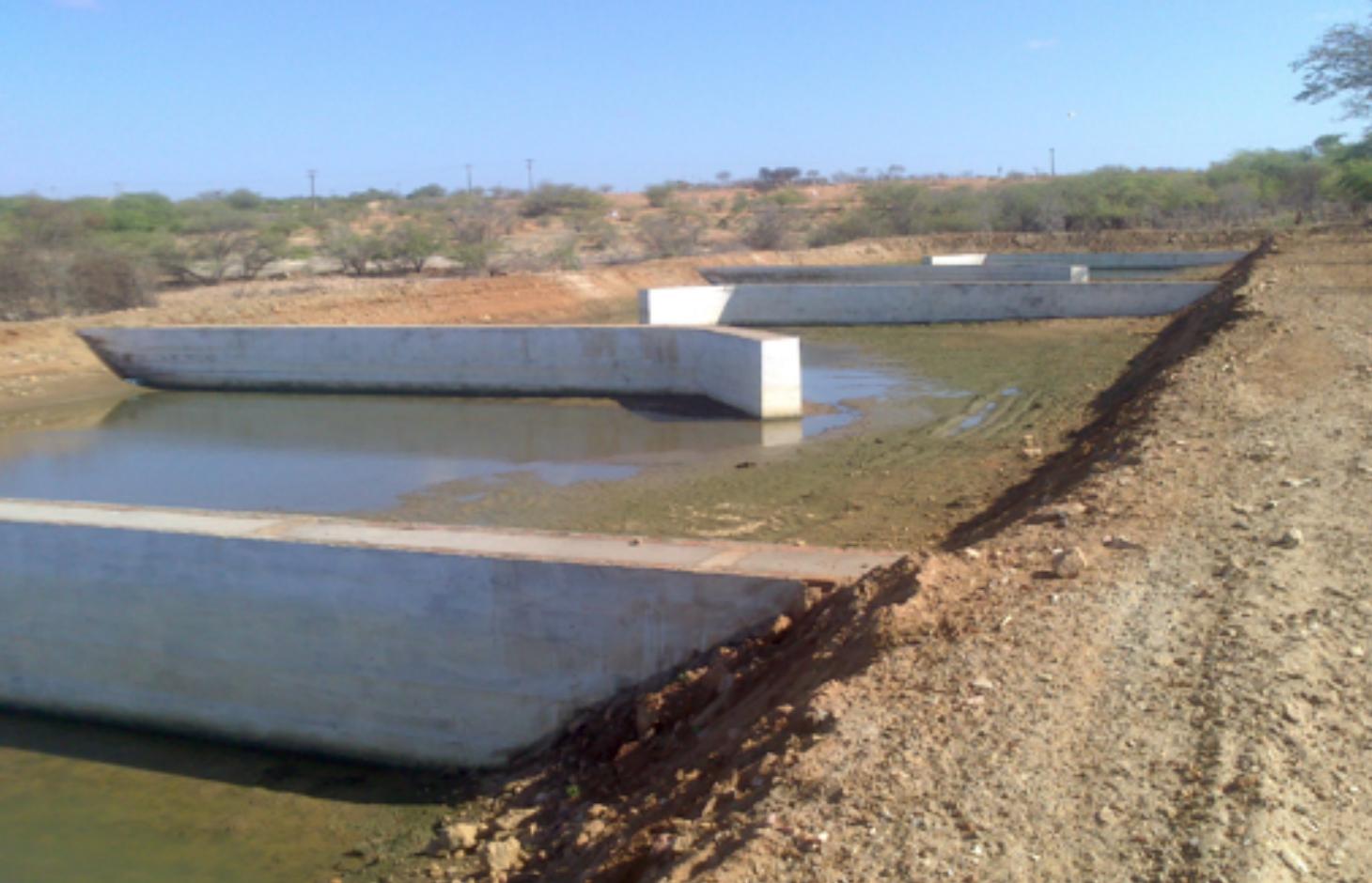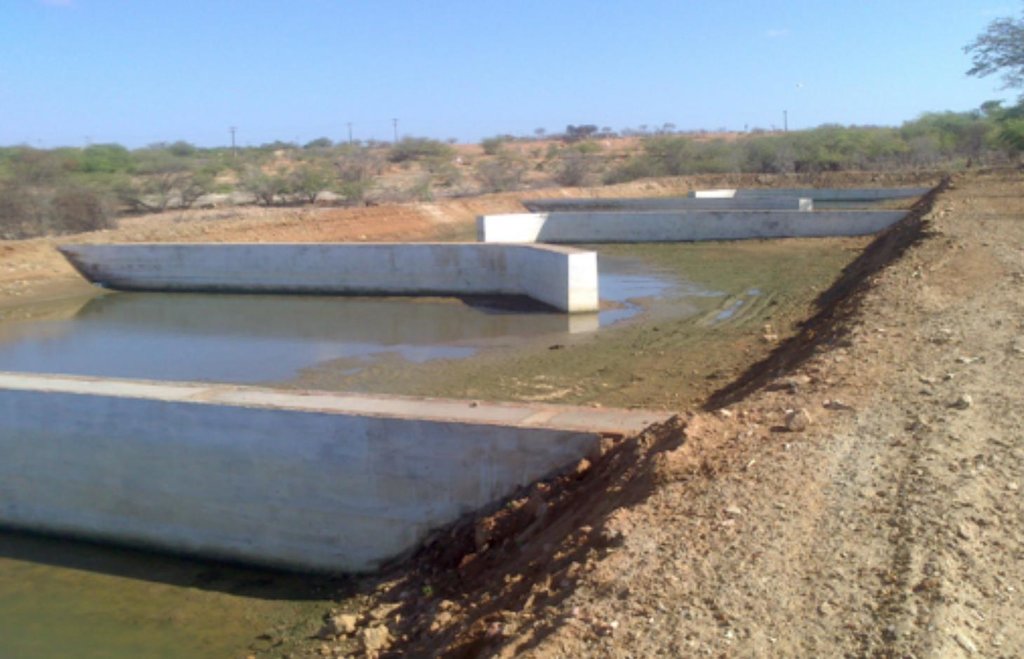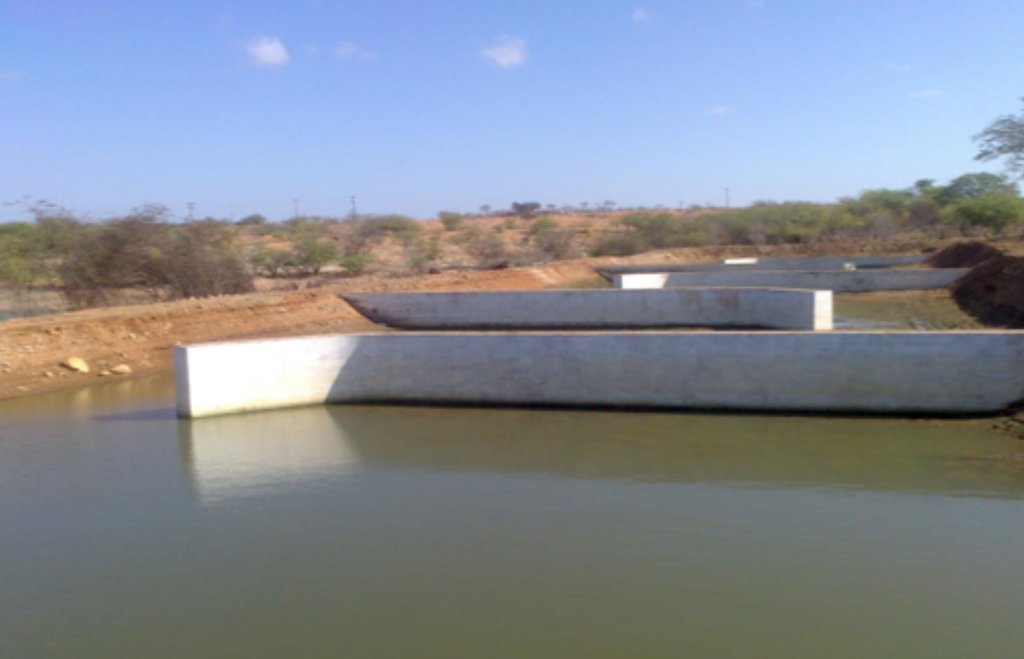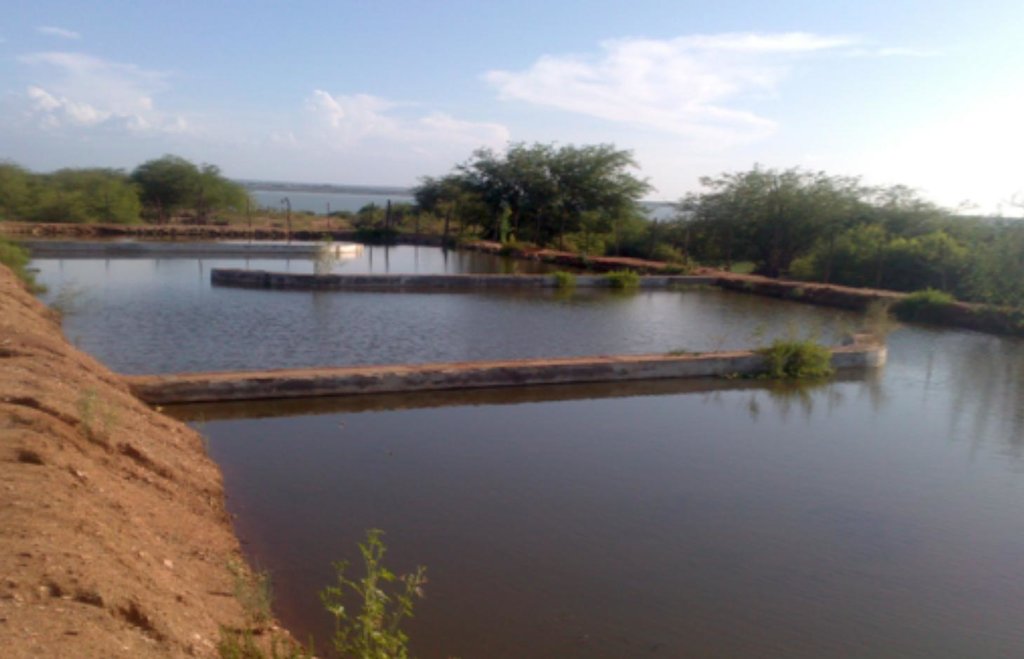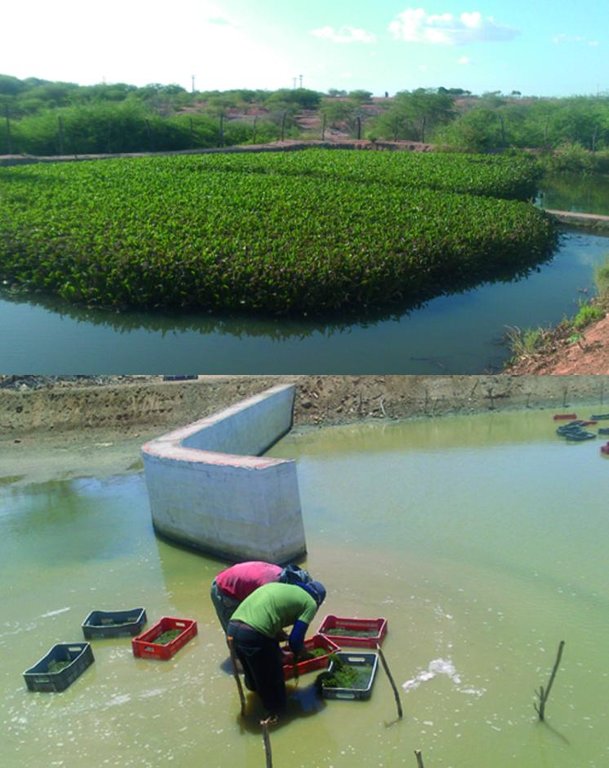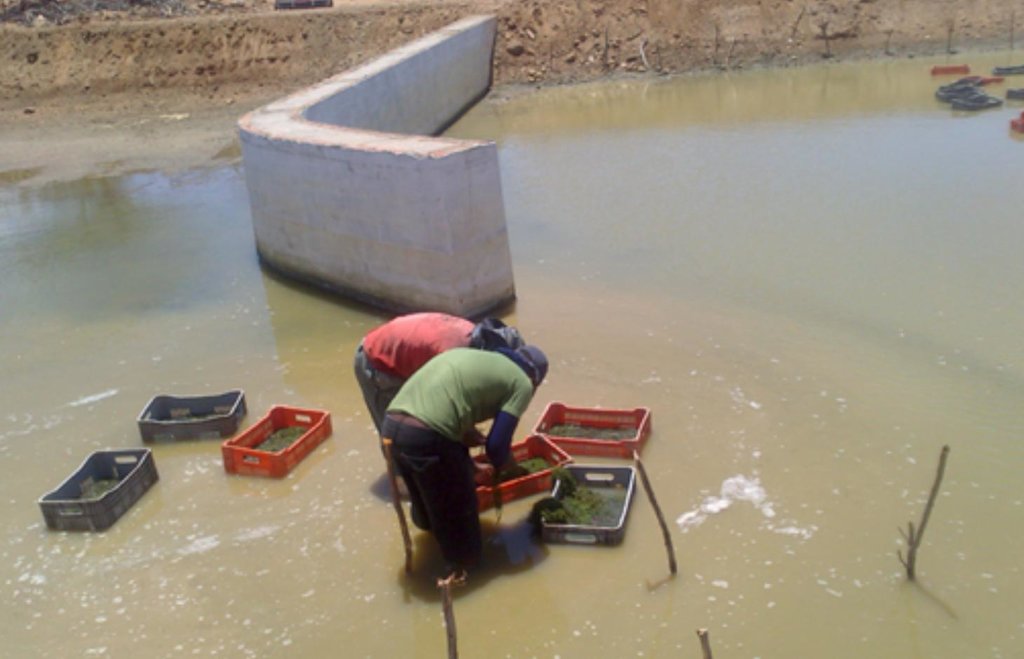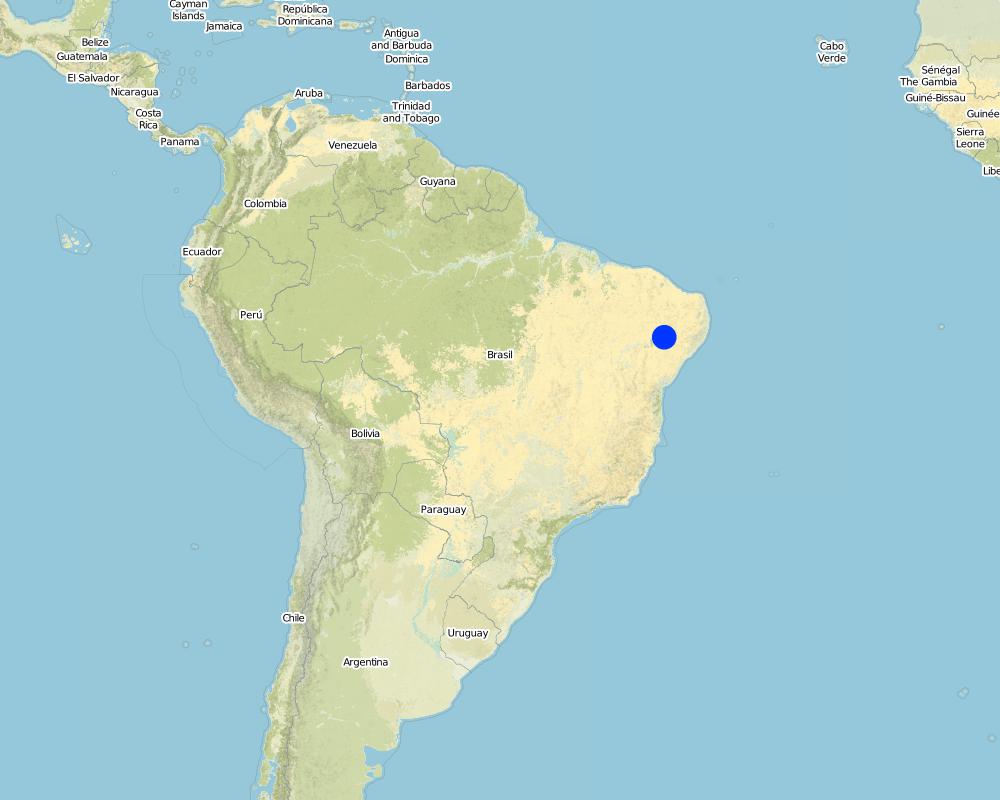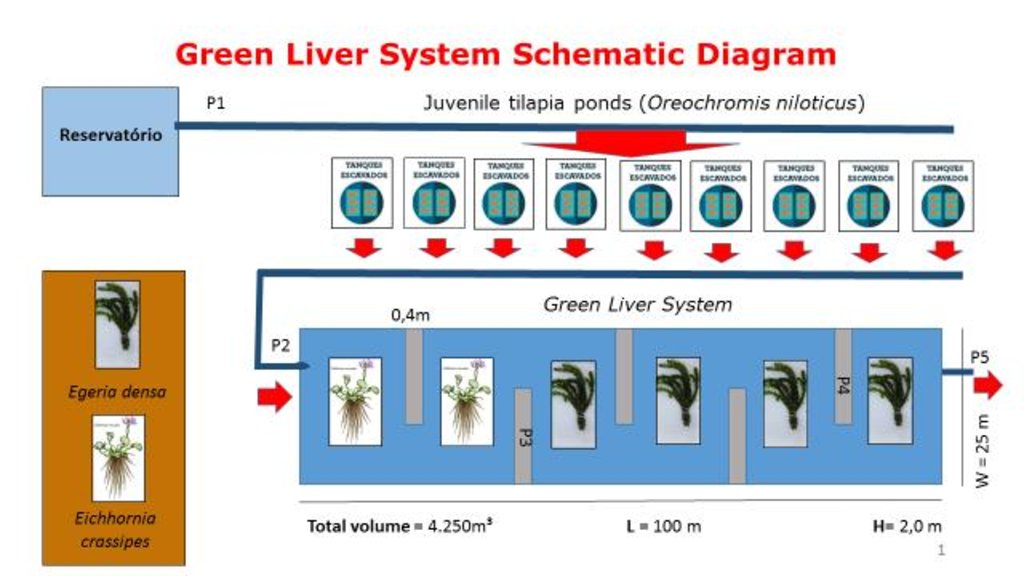The “Green Liver System”: eco-friendly water purification [巴西]
- 创建:
- 更新:
- 编制者: Marianna Siegmund-Schultze
- 编辑者: –
- 审查者: Alexandra Gavilano, Fabian Ottiger, David Streiff
Fitorremediação (Portuguese)
technologies_1710 - 巴西
- The “Green Liver System”: eco-friendly water purification : March 7, 2019 (public)
- The “Green Liver System”: eco-friendly water purification : April 29, 2017 (inactive)
- The “Green Liver System”: eco-friendly water purification : March 20, 2017 (inactive)
- The “Green Liver System”: eco-friendly water purification: March 8, 2017 (inactive)
- The “Green Liver System”: eco-friendly water purification: March 7, 2017 (inactive)
查看章节
全部展开 全部收起1. 一般信息
1.2 参与该技术评估和文件编制的资源人员和机构的联系方式
SLM专业人员:
SLM专业人员:
有助于对技术进行记录/评估的项目名称(如相关)
Book project: Making sense of research for sustainable land management (GLUES)有助于对技术进行记录/评估的项目名称(如相关)
Interplay among multiple uses of water reservoirs via innovative coupling of substance cycles in aquatic and terrestrial ecosystems (INNOVATE / GLUES)有助于对技术进行记录/评估的机构名称(如相关)
Leibniz-Institut für Gewässerökologie und Binnenfischerei (IGB) - 德国有助于对技术进行记录/评估的机构名称(如相关)
Potsdam-Institut für Klimaforschung (PIK) - 德国有助于对技术进行记录/评估的机构名称(如相关)
Universität Hohenheim - 德国有助于对技术进行记录/评估的机构名称(如相关)
Technische Universität Berlin (Technische Universität Berlin) - 德国有助于对技术进行记录/评估的机构名称(如相关)
Hochschule für Technik und Wirtschaft Dresden (HTW Dresden) - 德国1.3 关于使用通过WOCAT记录的数据的条件
编制者和关键资源人员接受有关使用通过WOCAT记录数据的条件。:
是
2. SLM技术的说明
2.1 技术简介
技术定义:
Water purification using macrophytes to treat effluent from fish farming.
2.2 技术的详细说明
说明:
The Itaparica reservoir was completed in 1988 to generate hydropower. About 40'000 people were compulsorily relocated. The construction of the reservoir lead to a shortage of fish, making aquaculture a viavle and profitable alternative. However excess feed and excreta of fish add nutrients and pollute water.
The “Green Liver System” uses aquatic plants, established in artificial wetlands, to remove, transfer, stabilize or eliminate pollutants in wastewater from fish farms. The use of large quantities of feed in aquaculture, along with the application of antibiotics, hormones and probiotics, has negative impacts on aquatic ecosystems due to the introduction of nitrogen, phosphorous and drug residues into the system. The Green Liver System is a form of phytoremediation (phyto = plant and remediate = correct) that uses a range of plants to decompose, extract, or hold contaminants present in soils and waters. This technology has been considered as an innovative alternative and a low cost option compared to others used in contaminated sites - like membrane bioreactors, upflow anaerobic sludge blanket (UASB), and others.
The plants selected for use in Green Liver System artificial wetlands depend on the pollutant to be removed. Research shows physiological differences between species, which need to be taken into account when planning wastewater treatments. Ideal plants for phytoremediation need: a) a fast growth rate; b) high biomass production; c) long rooting systems; d) easy maintenance/pruning; e) to be able to persists, and f) to have the ability to store trace metals within specific parts which can be later removed.
The Green Liver System uses aquatic macrophytes, which extract contaminants from the water, store them, or even metabolize them - transforming them into less toxic or harmless products. In the case of Eichhornia crassipes, most of the solids in suspension are removed by sedimentation or by adsorption in the root system. The dense coverage of these plants reduces the mixing effect of the wind, as well as minimizing thermal mixture. Shading by the plants restricts algal growth and the root system prevents horizontal movement of particulate material. In this way, particles are removed from the wastewater and microorganisms associated with the plants’ rhizosphere slowly decompose. Many organisms can be used in biodegradation: these include bacteria and fungi as well as plants, and the efficiency of one or the other depend, in many cases, on the molecule structure and of the presence of enzymes that are effective in degrading the pollutant.
The fish farm used as an example here is located on the margins of the Itaparica reservoir in Brazil. There are dozens of excavated tanks used to produce tilapia (Oreochromis niloticus) and “tambaqui” (Colossoma macropomum) fingerlings and juvenile fish. As well as these tanks, there are many net enclosures installed in the reservoir where the fishes are reared to maturity. Part of the wastewater from the excavated tanks is released into a stabilization lagoon, and the remainder goes to the Green Liver System. The effluent is enriched with spare feed, and excreta from the fish, which includes drug residues. If not treated, this may cause eutrophication because of its mineral richness. The Green Liver System consists of an excavated tank of 100m x 20m x 2m in size. The tank is subdivided into six parts: two planted to Eichhornia crassipes and four to Egeria densa. A mesh barrier stops fish from being flushed into the tank. Regular monitoring of the physical, chemical and biological parameters is required to control environmental fluctuations.
2.3 技术照片
2.5 已应用该技术的、本评估所涵盖的国家/地区/地点
国家:
巴西
区域/州/省:
Pernambuco
有关地点的进一步说明:
Vila do Coité, Itacuruba
具体说明该技术的分布:
- 适用于特定场所/集中在较小区域
注释:
Total area covered by the SLM Technology is 2 km2.
The reservoir is 100m long and 20 m wide, with a depth of 1.7 m, but the area may be larger depending on the volume of effluent to be treated. The whole area comprises the fish ponds.
Map
×2.6 实施日期
如果不知道确切的年份,请说明大概的日期:
- 不到10年前(最近)
2.7 技术介绍
详细说明该技术是如何引入的:
- 在实验/研究期间
注释(项目类型等):
Construction took place in 2013, building on earlier experiences of the principal scientist, for instance in South Korea.
3. SLM技术的分类
3.1 该技术的主要目的
- 保护生态系统
3.2 应用该技术的当前土地利用类型

牧场
动物类型:
- 山羊

水道、水体、湿地
- 池塘、大坝
注释:
Major land use problems (compiler’s opinion): The Itaparica reservoir was completed in 1988 to generate hydropower. About 40,000 people were compulsorily relocated. The construction of the reservoir had interrupted fish movement, leading to a shortage of fish, making aquaculture a viable and profitable alternative, and current law allows this. However excess feed and excreta of fish, partly containing drug residues, add nutrients and pollute water. ECONOMIC ASPECTS: The agricultural economy of this semi-arid region is characterized by pastoral activities, as well as the cultivation of crop species resistant to drought, such as cotton, corn (maize), beans, and cassava in humid areas. Irrigation from the reservoir was potentially possible but investments in aquaculture proved more profitable. In general, the commercial companies involved do not treat effluent, leading to pollution. Even though monitoring is mandatory, almost nobody does it, nor do they make substantial efforts to purify the effluent.
Major land use problems (land users’ perception): There are several conflicts over water and related land use in the region. Some people say the water quality in the reservoir is good (and use it directly for drinking), others report ill-health especially during times of low water levels. Commercial aquaculture primarily produces tilapia. Invariably, some tilapia escape from their net cages and take over from other local species. The hydroelectric company manages the reservoir according to national needs in electricity – thus sudden water level fluctuations are frequent. Commercial aquaculture and associated land use dominate the shoreline, preventing access for artisanal fishermen to their traditional fishing grounds.
Future (final) land use (after implementation of SLM Technology): Other: Ow: Waterways, drainage lines, ponds, dams
Constraints of transition land, fallow or sporadicall used by roaming livestock (mainly goats) (area in between the land-based aquaculture and the lake)
Number of growing seasons per year: 1
Longest growing period from month to month: all year due to tropical climate
3.3 由于技术的实施,土地使用是否发生了变化?
由于技术的实施,土地使用是否发生了变化?:
- 是(请在技术实施前填写以下有关土地利用的问题)

牧场
3.4 供水
该技术所应用土地的供水:
- 混合雨水灌溉
3.5 该技术所属的SLM组
- 地表水管理(泉、河、湖、海)
- 湿地保护/管理
- water purification
3.6 包含该技术的可持续土地管理措施

植物措施
- V5:其它

结构措施
- S5:大坝、集水斗、水池
注释:
Specification of other vegetative measures: macrophytes, different species
Type of vegetative measures: in blocks
3.7 该技术强调的主要土地退化类型

水质恶化
- Hp:地表水水质下降
注释:
Main causes of degradation:
Direct causes - Human induced: deforestation / removal of natural vegetation (incl. forest fires) (slash-and-burn practices), over-exploitation of vegetation for domestic use (firewood and charcoal making), overgrazing (free roaming run-wild donkeys, and small ruminants), urbanisation and infrastructure development (construction works near to body bodies (not respecting conservation areas)), discharges (point contamination of water) (indiscriminate disposal of effluents; excrements, drugs and surplus feed from fishes in net-cages), over abstraction / excessive withdrawal of water (for irrigation, industry, etc.) (abstraction of water from the reservoir without prior registration, not holding water use permits)
Direct causes - Natural: change in temperature (supposed to be climate change induced), change of seasonal rainfall (high variability in semi-arid regions rather normal; though rainfall appears to fall in shorter periods), droughts (recurrent droughts are "normal", they appear to last for longer periods)
Indirect causes: poverty / wealth (limited livelihood sources in the rather remote municipality), inputs and infrastructure: (roads, markets, distribution of water points, other, …) (spoilage and low quality), education, access to knowledge and support services (often little value attached to natural resources), war and conflicts (conflicts among two families; conflicts among indigenous and commercial users), governance / institutional (restricted enforcement of existing rules; clientelism)
Secondary causes of degradation: soil management, crop management (annual, perennial, tree/shrub), industrial activities and mining, release of airborne pollutants (urban/industry…), disturbance of water cycle (infiltration / runoff), Heavy / extreme rainfall (intensity/amounts), wind storms / dust storms, floods, other natural causes (avalanches, volcanic eruptions, mud flows, highly susceptible natural resources, extreme topography, etc.) specify, population pressure, land tenure, labour availability
3.8 防止、减少或恢复土地退化
具体数量名该技术与土地退化有关的目标:
- 减少土地退化
4. 技术规范、实施活动、投入和成本
4.1 该技术的技术图纸
技术规范(与技术图纸相关):
The constructed wetland termed a “Green Liver System” is 100m x 25m x 2.0m in size. It is divided into six parts (one third of the tank planted with Eichhornia crassipes the remainder with Egeria densa). The average outflow during the period was 1,800 m³/h. Point P1 is the catchment from the reservoir. Point P2 is the inlet that receives the discharge of effluent from 10 ponds with juvenile tilapia (Oreochromis niloticus). Point P3 is the stage after the treatment with Eichhornia crassipes. Point P4 is the stage of the treatment with Egeria densa. Point P5 is the outlet into a containment basin.
Location: Itacuruba. Pernambuco
Date: 2013
Technical knowledge required for field staff / advisors: high (It is a sophisticated system which requires close observation and monitoring. Site-specific adaptation might be necessary (for instance fencing to avoid goats entering the area).)
Technical knowledge required for land users: high (It is a sophisticated system which requires close observation and monitoring. It will be easier with some experience.)
Main technical functions: improvement of water quality, buffering / filtering water
In blocks
Vegetative material: O : other
Number of plants per (ha): 250000
Other species: Egeria densa; Eichhornia crassipes
Dam/ pan/ pond
Depth of ditches/pits/dams (m): 1.7
Width of ditches/pits/dams (m): 20
Length of ditches/pits/dams (m): 100
Wall/ barrier
Depth of ditches/pits/dams (m): 1.7
Width of ditches/pits/dams (m): ca 0.3
Length of ditches/pits/dams (m): ca 15
Construction material (other): tubes, valves
Specification of dams/ pans/ ponds: Capacity 3400m3
Dimensions of spillways: ca 100m
作者:
Stephan Pflugmacher-Lima, TUB, Faculty VI Planning Building Environment; Sekr. A1; Str des 17. Juni 152; 10623 Berlin; Germany
4.2 有关投入和成本计算的一般信息
具体说明成本计算所用货币:
- 美元
如相关,注明美元与当地货币的汇率(例如1美元=79.9巴西雷亚尔):1美元=:
3.17
注明雇用劳工的每日平均工资成本:
25.00
4.3 技术建立活动
| 活动 | 时间(季度) | |
|---|---|---|
| 1. | Digging the pit (truck) , stabilizing the walls | |
| 2. | Building separation walls (construction costs: USD 3000 / unit) | |
| 3. | Fencing (cutting fence posts: USD 160 / unit) | |
| 4. | Planting macrophytes in place (costs: USD 1900 / unit) |
4.4 技术建立所需要的费用和投入
| 对投入进行具体说明 | 单位 | 数量 | 单位成本 | 每项投入的总成本 | 土地使用者承担的成本% | |
|---|---|---|---|---|---|---|
| 劳动力 | Construction | 1.0 | 5060.0 | 5060.0 | ||
| 劳动力 | Supervision | 1.0 | 1000.0 | 1000.0 | ||
| 设备 | Truck for removal of soil | 1.0 | 125.0 | 125.0 | ||
| 施工材料 | Walls/baffles (cement) | 1.0 | 475.0 | 475.0 | ||
| 施工材料 | Barbed wire | 1.0 | 315.0 | 315.0 | ||
| 施工材料 | Earthwork | 1.0 | 250.0 | 250.0 | ||
| 施工材料 | Tubular elements | 1.0 | 30.0 | 30.0 | ||
| 技术建立所需总成本 | 7255.0 | |||||
| 技术建立总成本,美元 | 2288.64 | |||||
4.5 维护/经常性活动
| 活动 | 时间/频率 | |
|---|---|---|
| 1. | Exchange macrophytes |
4.6 维护/经常性活动所需要的费用和投入(每年)
| 对投入进行具体说明 | 单位 | 数量 | 单位成本 | 每项投入的总成本 | 土地使用者承担的成本% | |
|---|---|---|---|---|---|---|
| 劳动力 | Labour | 1.0 | 3000.0 | 3000.0 | ||
| 设备 | Nylon fabric | 1.0 | 38.41 | 38.41 | ||
| 技术维护所需总成本 | 3038.41 | |||||
| 技术维护总成本,美元 | 958.49 | |||||
注释:
Because of the tropical climate of Brazilian northeast there is a need to remove Eichhornia crassipes periodically because it grows very quickly as there is plenty nutrients and warm temperatures during all year. The cost of removal of the macrophytes is permanent and must be made monthly as the plant reaches adulthood it loses its capability in removing nutrients and gives it back to the water.
5. 自然和人文环境
5.1 气候
年降雨量
- < 250毫米
- 251-500毫米
- 501-750毫米
- 751-1,000毫米
- 1,001-1,500毫米
- 1,501-2,000毫米
- 2,001-3,000毫米
- 3,001-4,000毫米
- > 4,000毫米
有关降雨的规范/注释:
It happened to be less than 100mm in 2013. Very unreliable rainfall pattern. Rainfall from Dezember to May, most rain often in March
农业气候带
- 半干旱
Thermal climate class: tropics. Bsh according to Köppen classification
5.2 地形
平均坡度:
- 水平(0-2%)
- 缓降(3-5%)
- 平缓(6-10%)
- 滚坡(11-15%)
- 崎岖(16-30%)
- 陡峭(31-60%)
- 非常陡峭(>60%)
地形:
- 高原/平原
- 山脊
- 山坡
- 山地斜坡
- 麓坡
- 谷底
垂直分布带:
- 0-100 m a.s.l.
- 101-500 m a.s.l.
- 501-1,000 m a.s.l.
- 1,001-1,500 m a.s.l.
- 1,501-2,000 m a.s.l.
- 2,001-2,500 m a.s.l.
- 2,501-3,000 m a.s.l.
- 3,001-4,000 m a.s.l.
- > 4,000 m a.s.l.
5.3 土壤
平均土层深度:
- 非常浅(0-20厘米)
- 浅(21-50厘米)
- 中等深度(51-80厘米)
- 深(81-120厘米)
- 非常深(> 120厘米)
土壤质地(表土):
- 中粒(壤土、粉土)
土壤质地(地表以下> 20厘米):
- 中粒(壤土、粉土)
表土有机质:
- 低(<1%)
如有可能,附上完整的土壤描述或具体说明可用的信息,例如土壤类型、土壤酸碱度、阳离子交换能力、氮、盐度等。:
Soil fertility is low
Soil drainage/infiltration is poor (e.g. sealing/crusting)
Soil water storage capacity is very low
5.4 水资源可用性和质量
地下水位表:
< 5米
地表水的可用性:
匮乏/没有
水质(未处理):
不良饮用水(需要处理)
5.5 生物多样性
物种多样性:
- 中等
5.6 应用该技术的土地使用者的特征
非农收入:
- > 收入的50%
相对财富水平:
- 平均水平
- 丰富
个人或集体:
- 个人/家庭
性别:
- 男人
说明土地使用者的其他有关特征:
Land users applying the Technology are mainly common / average land users
Population density: < 10 persons/km2
Annual population growth: 1% - 2%
5.7 应用该技术的土地使用者使用的平均土地面积
- < 0.5 公顷
- 0.5-1 公顷
- 1-2 公顷
- 2-5公顷
- 5-15公顷
- 15-50公顷
- 50-100公顷
- 100-500公顷
- 500-1,000公顷
- 1,000-10,000公顷
- > 10,000公顷
这被认为是小规模、中规模还是大规模的(参照当地实际情况)?:
- 小规模的
5.8 土地所有权、土地使用权和水使用权
土地所有权:
- 个人,未命名
- 个人,有命名
土地使用权:
- 个人
- needs official registration and permission; heavy water use has a price
- needs official registration and permission; heavy water use has a price
5.9 进入服务和基础设施的通道
健康:
- 贫瘠
- 适度的
- 好
教育:
- 贫瘠
- 适度的
- 好
技术援助:
- 贫瘠
- 适度的
- 好
就业(例如非农):
- 贫瘠
- 适度的
- 好
市场:
- 贫瘠
- 适度的
- 好
能源:
- 贫瘠
- 适度的
- 好
道路和交通:
- 贫瘠
- 适度的
- 好
饮用水和卫生设施:
- 贫瘠
- 适度的
- 好
金融服务:
- 贫瘠
- 适度的
- 好
extension service:
- 贫瘠
- 适度的
- 好
6. 影响和结论性说明
6.1 该技术的现场影响
社会经济效应
水资源可用性和质量
饮用水的可用性
家畜用水的可用性
灌溉用水的可用性
收入和成本
收入来源的多样性
注释/具体说明:
Biomass of macrophytes for potential ethanol production.
其它社会经济效应
Labour cost
注释/具体说明:
Increase of maintenance costs as manual labor is required for management of macrophytes.
社会文化影响
SLM/土地退化知识
注释/具体说明:
Better water management in a setting of decreasing seasonal rainfall.
Improved livelihoods and human well-being
注释/具体说明:
The technology contributed to improved water quality, which is directly related to people's health.
生态影响
水循环/径流
水质
蒸发
注释/具体说明:
Any open water body is subjected to the very high potential evaporation in the region. Though, the surface of the system is very small as compared to the adjacent reservoir.
土壤
土壤覆盖层
注释/具体说明:
The vegetation had to be removed in order to construct the artificial wetland.
其它生态影响
Vulnerability
注释/具体说明:
A nylon grid prevents the macrophytes from occasionally breaking loose into the reservoir.
The ecology of the system is sort of fragile. If the macrophytes float too much, the system can break down.
6.2 该技术的场外影响已经显现
Contribution to human well-being/livelihoods and support to decrease eutrophication in reservoir and channels
注释/具体说明:
the technology contributed to improved water quality, which is directly related to people's health.
6.4 成本效益分析
技术收益与技术建立成本相比如何(从土地使用者的角度看)?
短期回报:
积极
长期回报:
积极
技术收益与技术维护成本/经常性成本相比如何(从土地使用者的角度看)?
短期回报:
积极
长期回报:
积极
6.5 技术采用
注释:
There is a little trend towards spontaneous adoption of the Technology. A broad adoption is not yet expectable at this stage of experimental analysis and testing. Few people did already express their interest.
6.7 该技术的优点/长处/机会
| 土地使用者眼中的长处/优势/机会 |
|---|
| If the environmental authority increases controls of how effluent from aquaculture ponds is handled (checking pollution and nutrient loads in the effluent which is usually returned to the reservoir without any treatment), the technology would help compliance with existing rules. --> Enhancing control and penalties would favor the adoption of such a green technology. Currently controls are rare or non-existent. |
| The technology can be constructed using locally available material. --> As long as cheap labour is available and rural shops exist, the availability of inputs is adequate. |
| 编制者或其他关键资源人员认为的长处/优势/机会 |
|---|
| Water purification is realized by using natural processes. --> If the related tilapia fish production unit could be awarded a "green" or "ecological" brand, this would be beneficial and maybe trigger the adoption of the technology |
| Among the advantages of adopting the Green Liver technology are the low costs, the speed of construction and it's relatively easy operation. --> Easily accessible and comprehensive information is needed, as well as the possibility of exchanging experience among users or future users. |
6.8 技术的弱点/缺点/风险及其克服方法
| 土地使用者认为的弱点/缺点/风险 | 如何克服它们? |
|---|---|
| Additional manual labour increases costs (and hinders adoption) | The more people use such techniques, for instance due to improved environmental monitoring and fines imposed, the more such extra expenditure will be accepted as regular running costs. |
| The management of the system is not simple. Many different and unexpected disturbances can occur. Experience and close, constant watch out is needed. | Exchange of experience among users would facilitate its management. An updated list of threats could be helpful. |
| 编制者或其他关键资源人员认为的弱点/缺点/风险 | 如何克服它们? |
|---|---|
| From time to time the macrophytes have to be removed, tubes may need cleaning and the system needs to be set up again. Sometimes, the removal of almost all water may be indicated. Major maintenance can cause peak labour needs. Manual labour required to monitor the system on a regular basis, and perform maintenance according to needs. Depending on the number and size of Green Liver Systems in action, caring for them can be a full-time job. | The maintenance costs have to be well budgeted in the overall planning of costs and benefits of the related productive units. |
| The disposal of the removed macrophytes is still a problem to be solved. If the macrophytes have accumulated high levels of toxins, the biomass cannot be used for compost making or livestock feeding. | The removed macrophytes should be analysed for their pollutant content. A biodigester could be the solution to the disposal of contaminated biomass, generating energy for the productive unit and possibly for the local population too. |
7. 参考和链接
7.1 信息的方法/来源
- 实地考察、实地调查
- 与土地使用者的访谈
7.2 参考可用出版物
标题、作者、年份、ISBN:
Pflugmacher, S., Kühn, S., Lee, S.-H., Choi, J.-W., Baik, S., Kwon, K.-S., Contardo-Jara, V., 2015. Green Liver Systems® for water purification: Using the phytoremediation potential of aquatic macrophytes for the removal of different cyanobacterial toxins from water.
可以从哪里获得?成本如何?
AJPS 06 (09), 1607–1618. doi:10.4236/ajps.2015.69161.
标题、作者、年份、ISBN:
Nimptsch, J., Wiegand, C., Pflugmacher, S., 2008. Cyanobacterial toxin elimination via bioaccumulation of MC-LR in aquatic macrophytes: An application of the “Green Liver Concept”
可以从哪里获得?成本如何?
Environ. Sci. Technol. 42 (22), 8552–8557. doi:10.1021/es8010404.
链接和模块
全部展开 全部收起链接
无链接
模块
无模块


